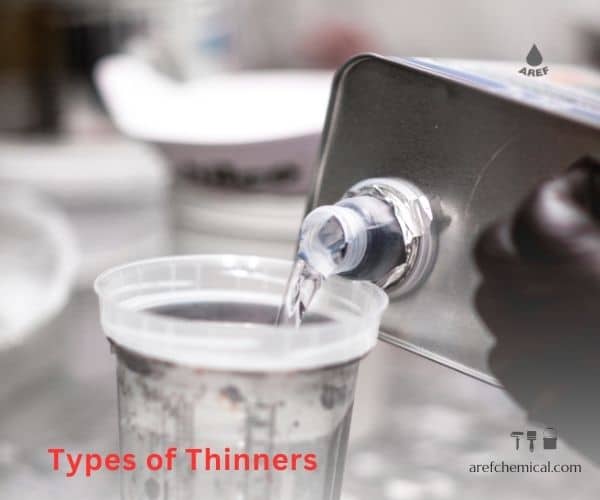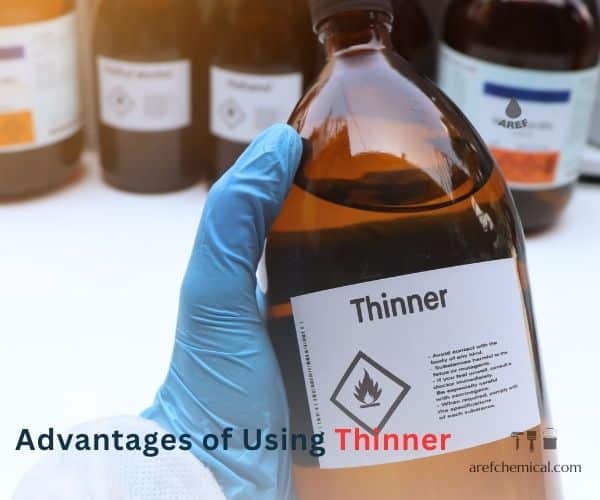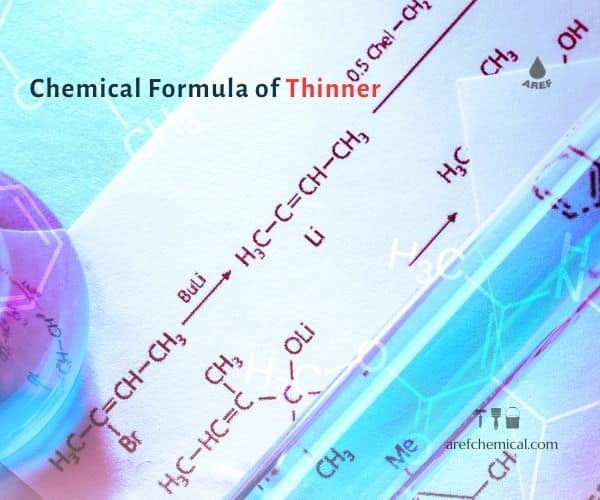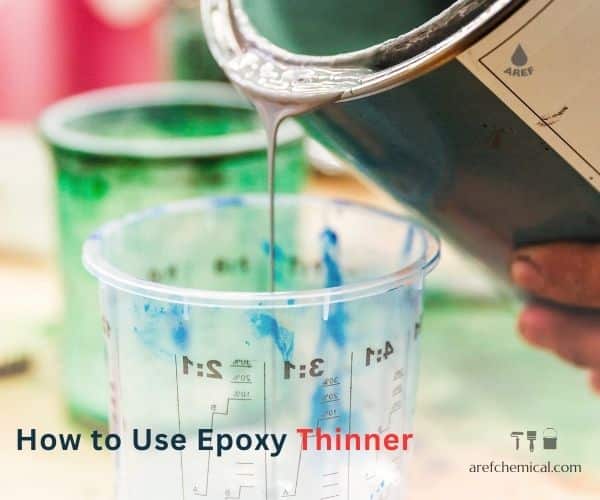What is Thinner? Thinner is one of the commonly used chemicals in various industries, serving as a diluent or solvent. These substances are typically based on organic solvents and play a key role in painting, lacquering, and cleaning tools. Thinners not only help improve the quality and uniformity of paints, but they also reduce drying time and make cleaning operations easier. Despite their numerous advantages, the use of thinner requires adherence to specific safety precautions, as its vapors can be hazardous to health. Therefore, awareness of safe usage methods and proper storage of this substance, alongside understanding its applications, is of great importance. Now, let’s explore the types of thinners, their applications, advantages, and safety tips for their use.
Definition of Thinner
Thinner refers to chemical substances that are used for diluting or dissolving paints and polymer materials. This substance acts as a solvent and can increase the fluidity of paints, facilitating the painting process. Thinners are usually produced based on hydrocarbons, alcohols, and other organic compounds. This liquid chemical is primarily used to dilute paints, lacquers, and other industrial compounds. It typically consists of a mixture of organic solvents and acts as a solvent that can render media compounds usable. Thinners help improve the painting properties and drying of materials and are also used for cleaning tools and equipment after the application of paint and lacquer.
Despite their extensive applications, thinners should be handled with caution and adherence to safety principles, as their vapors can be harmful to health and may cause damage to the respiratory system, skin, and eyes. What is Thinner? Now you know it.
Types of Thinners
Thinner is a commonly used chemical in various industries, primarily as a solvent and diluent in paints, lacquers, and similar products. Thinners are categorized into different types, which are outlined below:
- Organic Thinners: These include aromatic hydrocarbons, alcohols, and esters. These thinners are widely used due to their high solvency properties.
- Inorganic Thinners: include mineral substances such as gasoline and kerosene. This type of thinner is also commonly used as a solvent, but compared to organic thinners, it may have fewer properties.
- Acrylic Thinners: These thinners are often used in acrylic paints and help enhance performance and solubility.
- Fast-Drying Thinners: This type of thinner is used for diluting fast-drying paints, sealers, varnishes, and nitrocellulose. Fast-drying thinners evaporate quickly, making them suitable for applications that require rapid drying.
- Oil-Based Thinners: These thinners are used for diluting oil-based and alkyd paints. Oil-based thinners take longer to evaporate and are suitable for applications that require more working time. What is Thinner? Now you know it.
Applications of Thinners
Based on the previous explanations, what are the applications of thinners, and in which industries are they used? Thinners have numerous applications in various industries and activities, and some of the most important ones include:
- Diluting Paints and Lacquers: Thinners are used as a diluent to reduce the viscosity of paints and lacquers, making them easier to apply.
- Solvent: Thinners can act as solvents for various compounds, including resins and plastics, aiding in their mixing.
- Cleaning: Thinners are used for cleaning tools and equipment that have worked with paint or lacquer. This substance can easily remove paint and grease residues. Thinners serve as an effective cleaner for removing leftover paint from tools and different surfaces.
- Machinery and Equipment: In some industries, thinners are used for cleaning and maintaining machines and equipment to optimize their performance.
- Chemical Production: Some thinners serve as components in the production process of other chemicals.
- Automotive Industry: In the automotive sector, thinners are used for painting and repairing vehicle bodies.
- Painting: Thinners are used as diluents for paints. This substance helps create a smooth and uniform layer.
- Printing Industry: In printing industries, thinners are used as solvents for printing inks.
- Adhesive Industry: In the adhesive industry, thinners are used as diluents to thin adhesives and increase bonding strength while speeding up the drying process.
- Electronics Industry: Thinners are used for cleaning and removing residues from electronic components and printed circuit boards.
Thinners can also be used for purposes such as diluting resins, cleaning tools, separating stuck parts, and disinfecting surfaces. However, the use of thinners must be done cautiously, and safety precautions should be strictly followed. What is Thinner? Now you know it.
Advantages of Using Thinner
The use of thinner offers many benefits, some of which are mentioned below:
– Tool Cleaning: Thinner is effective in cleaning tools such as brushes and rollers that have been used with paint, which increases the lifespan of these tools.
– Facilitating Drying: Using thinner can reduce the drying time of paint or lacquer, allowing tasks to be completed more quickly.
– Impact on Final Quality: Thinner can improve the final quality of the work, contributing to a smooth and uniform surface.
– Surface Preparation: Before applying paint or coating materials, thinner can be used to clean and prepare surfaces.
– Easier Process: The use of thinner can simplify the painting process and make tasks easier.
– Improved Paint Quality: Thinner allows for better and more uniform application of paints on surfaces.
– Reduced Drying Time: Adding thinner decreases the drying time of paint, thus enhancing efficiency in large projects.
– Solvency Capability: Thinner dissolves a wide range of materials, including resins, adhesives, and coatings, making it useful for various applications.
– Affordable Price: Thinner is relatively inexpensive compared to other solvents.
– Easy Cleaning: Thinner effectively removes leftover paint from tools, facilitating the cleaning process.
Now we have a better understanding of the applications of thinner. When using thinner, safety should be a priority as the substance emits harmful vapors and should be used in well-ventilated areas.
Safety Precautions When Using Thinner
Despite the numerous benefits of thinner, the following safety precautions should be taken into account:
- Use Personal Protective Equipment: When working with thinner, wear gloves, protective eyewear, and a mask to avoid skin contact and inhalation of vapors.
- Proper Ventilation: Ensure that environments where thinner is used are properly ventilated to prevent the accumulation of harmful vapors.
- Proper Storage: Thinners should be stored in tightly sealed containers and kept out of reach of children, away from heat and fire sources.
- Awareness of Poisoning Symptoms: Recognize the symptoms of poisoning in case of inhalation of thinner vapors or skin contact. Seek medical attention immediately if any issues arise.
- Toxic and Flammable: Thinner is toxic and flammable, so it should be used with caution, and proper ventilation should be ensured while using it.
Always carefully read safety instructions before using thinner and use appropriate protective gear such as gloves, eyewear, and masks.
What is the Chemical Formula of Thinner?
Thinner is a mixture of various organic compounds and does not have a precise chemical formula. The compounds present in thinner can vary depending on the type of thinner and its application. Some common compounds in thinners include:
– Hydrocarbons: such as toluene, xylene, hexane, and pentane
– Acetone: CH3COCH3
– Ethanol: C2H5OH
– Isopropanol: C3H8O
– Ethyl acetate: C4H8O2
– Methanol: CH3OH
What is the precise formulation of thinner? Thinners are specifically designed to provide desired properties for specific applications. For example, oil-based thinners generally consist of longer-chain hydrocarbons, making them suitable for thinning oil-based paints. In contrast, solvent-based thinners typically comprise a mixture of acetone, ethanol, and isopropanol, making them suitable for cleaning surfaces and thinning adhesives.
The chemical composition is important for selecting the appropriate thinner for a specific application and ensuring its safe and effective use. What is Thinner? From now on you know the formula.
What is Thinner Solvent?
Thinner is a type of solvent commonly used for diluting paints, lacquers, and various chemicals. To better understand what a thinner solvent is, it can be a mixture of several different solvents that help facilitate the use of paints and create more uniform mixtures. Thinner is typically used in the painting, construction, woodworking, and furniture industries. It is important to handle it with care and pay special attention to safety precautions, as the vapors and chemicals present in thinners can be harmful. Always use appropriate safety equipment such as masks, gloves, and goggles.
What is Epoxy Thinner?
Epoxy thinner is a type of chemical solvent that is an instant thinner composed of several different chemical compounds. This solvent is based on cellulosic solvents and is used to dilute epoxy paints. The solvency power of epoxy thinner depends on its ability to dilute epoxy paints.
Advantages of Using Epoxy Thinner:
– Diluting Epoxy Paint: This is the primary application of epoxy thinner. By using this thinner, the viscosity of epoxy paint can be adjusted to the appropriate concentration for spraying, rolling, or brushing.
– Improving Epoxy Paint Properties: Epoxy thinner can enhance the adhesion, gloss, and smoothness of epoxy paint.
– Cleaning Tools and Equipment: Epoxy thinner is used to clean brushes, rollers, work surfaces, and other tools and equipment that have become contaminated with epoxy paint.
– Dissolving Cured Epoxy Resin: Epoxy thinner is employed to dissolve cured epoxy resin and clean surfaces that have accidentally come into contact with epoxy resin.
Types of Epoxy Thinner:
– Standard Epoxy Thinner: This is the most common type and is suitable for most applications.
– Quick-Drying Epoxy Thinner: This type evaporates quickly and is ideal for paints that need to dry rapidly.
– High-Density Epoxy Thinner: This type is designed for high-viscosity epoxy paints that are more difficult to dilute.
Safety Tips When Using Epoxy Thinner:
– Toxic and Flammable: Epoxy thinner is toxic and flammable, so it should be used with caution.
– Ensure Proper Ventilation: Make sure to use epoxy thinner in a well-ventilated area and use protective equipment such as gloves, goggles, and masks.
– Keep Out of Reach of Children and Pets: Store epoxy thinner in tightly closed containers and keep it away from children and animals.
– Read Safety Instructions: Carefully read the safety instructions on the epoxy thinner label.
How to Use Epoxy Thinner:
- Add a small amount of epoxy thinner to the epoxy paint.
- Mix the paint well until it becomes uniform.
- Gradually add more epoxy thinner if necessary to reach the desired consistency.
- Use the diluted epoxy paint according to the manufacturer’s instructions.
- After using epoxy thinner, clean brushes, rollers, and other tools with either epoxy thinner or soap and water.
Now you know it. What is Thinner? So use it safely.
Conclusion
Thinner is an efficient and widely used chemical in various industries, and its type and application can have positive impacts on work quality and project timelines. However, safe and informed use of thinner can help prevent health and safety issues. This article examined the types of thinners, their applications, benefits, and safety precautions when using them. Ultimately, it is always recommended to carefully read and follow the instructions regarding using and storing thinner. What is Thinner? Now you know it.








18 Responses
thinner is an efficient and so used chemical in various industries
https://behdama.com/%d9%85%d9%82%d8%a7%db%8c%d8%b3%d9%87-%da%a9%d9%88%d9%84%d8%b1-%da%af%d8%a7%d8%b2%db%8c-%d9%88-%da%a9%d9%88%d9%84%d8%b1-%d8%a2%d8%a8%db%8c/
What is Thinner? Now you know it.
https://behdama.com/%d8%a7%d9%81%d8%aa-%d9%81%d8%b4%d8%a7%d8%b1-%d9%be%da%a9%db%8c%d8%ac/
Read the safety instructions on the thinner label
https://behdama.com/%d9%be%da%a9%db%8c%d8%ac-%d8%a8%d8%b1%d9%82%db%8c/
thank you for learning How to Use Epoxy Thinner
https://behdama.com/%d9%be%d9%85%d9%be-%d8%ac%da%a9%d9%88%d8%b2%db%8c/
Be careful Epoxy thinner is flammable toxic
https://behdama.com/%d8%b9%d9%84%d8%a7%d8%a6%d9%85-%d8%ae%d8%b1%d8%a7%d8%a8%db%8c-%d9%85%d9%86%d8%a8%d8%b9-%d8%a7%d9%86%d8%a8%d8%b3%d8%a7%d8%b7-%d9%be%da%a9%db%8c%d8%ac/
really important
https://tavatranslation.com/
thanks for telling advantages
https://tavatranslation.com/%d8%b2%d9%86%d8%af%da%af%db%8c-%d9%88-%d9%81%d8%b1%d9%87%d9%86%da%af-%d8%af%d8%b1-%d8%a2%d9%84%d9%85%d8%a7%d9%86/
goood
https://tavatranslation.com/%d9%81%d8%b1%d8%b5%d8%aa-%d9%87%d8%a7%db%8c-%d8%b4%d8%ba%d9%84%db%8c-%d8%af%d8%b1-%d8%a2%d9%84%d9%85%d8%a7%d9%86/
https://tavatranslation.com/%d8%b2%d8%a8%d8%a7%d9%86-%d8%a8%db%8c%d9%86-%d8%a7%d9%84%d9%85%d9%84%d9%84%db%8c/
I enjoyed this issue
https://tavatranslation.com/%d8%b1%d9%88%d8%b4-%d8%af%d8%b1%db%8c%d8%a7%d9%81%d8%aa-%d9%88%db%8c%d8%b2%d8%a7%db%8c-%d8%aa%d8%ad%d8%b5%db%8c%d9%84%db%8c-%d8%a2%d9%84%d9%85%d8%a7%d9%86/
Do you have it in stock?
https://qomtamirat.com/
Thinner is a mixture of various organic compounds and does not possess a precise chemical formula. The specific compounds present in thinner can vary based on the type of thinner and its intended application.
Thinner is a solvent commonly used to dissolve paint, varnish, and other coatings, making it easier to apply and clean up after use. It typically consists of a mixture of volatile organic compounds (VOCs) and can come in various formulations for specific applications.
Thinners reduce the viscosity of paint, facilitating smoother application with brushes, rollers, or sprayers.
Used for cleaning brushes, rollers, and spray equipment after painting. Surface Preparation helps in cleaning surfaces to ensure proper adhesion of paint and finishes.
Artists use thinners to manipulate the consistency of oil paints or to clean their tools.
Often used in the formulation and application of adhesives, as it can help to adjust the flow and adhesion properties.
Automotive Industry used in automotive paint applications for both thinning and cleaning.